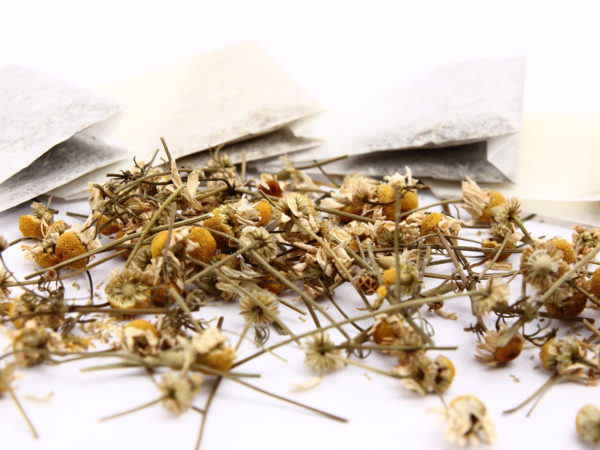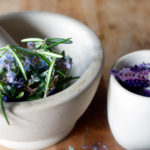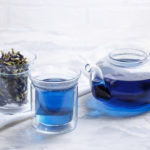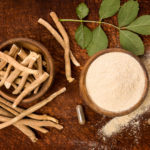Feverfew

Tanacetum parthenium
Feverfew is a flowering perennial herb native to Eurasia and found in Europe, Australia, and North and South America. It grows up to 24 inches tall in full sun, is a hardy herb (able to withstand −30 °C [−22 °F]), and is considered an invasive weed in some regions. The name derives from the Latin word febrifugia meaning “fever reducer.” Long used for medical purposes, it was documented by Greek herbalist Dioscorides as an anti-inflammatory. The daisy-like yellow flowers bloom between July and October, giving off a strong, bitter odor. Feverfew is closely related to the chrysanthemum.Traditionally, feverfew flowers and leaves were either chewed or ingested for their medicinal benefits. Today, the same methods of use are employed but now feverfew flowers and leaves are available in freeze-dried or dried form as well as in capsule, tablet, or liquid extract with standardized constituents. Feverfew contains parthenolide, a compound believed to reduce and prevent headaches and migraines.
Used for:
Feverfew is a traditional herb remedy commonly used to prevent headaches and migraines as well as treat arthritis and digestive issues.
While scientific evidence does not support the claims that feverfew provides arthritis relief and digestive support, there are studies that support its ability to prevent headaches and migraines. Feverfew contains parthenolide, a compound believed to be largely responsible for its therapeutic effects. One study looked at the experience of 72 volunteers who were given either a capsule of dried feverfew leaves daily or a placebo. After completion, the study showed a reduction in the number and severity of headache and migraine attacks indicating a significant improvement from using feverfew. The researchers also found there were no serious side effects as a result of taking feverfew during the study. However, other studies have failed to find the same results and suggested the benefits are due to the placebo effect. Feverfew’s efficacy may also be linked to its anti-inflammatory benefits and its melatonin constituents.
Natural Medicines Comprehensive Database (NMCD) concludes taking feverfew by mouth is possibly effective at reducing and preventing headaches and migraines. It also concludes feverfew is “possibly ineffective” for reducing symptoms of rheumatoid arthritis (RA).
Available in:
Fresh, freeze-dried, or dried leaves and flowers, capsules, tablets or standardized liquid extracts.
Herb / drug interactions:
Feverfew may affect how quickly the liver breaks down medications. Be cautious if you are on medications including diabetes medications and proton pump inhibitors that are changed or broken down by the liver. Also, feverfew may slow blood clotting and affect the ability of anticoagulant drugs to work properly.
Other safety concerns:
The NMCD rates feverfew as “likely safe” when used “short-term (up to four months).” The safety of feverfew beyond four months’ of use has not been studied. The NMCD considers feverfew as “possibly unsafe” to take during pregnancy and should be avoided during breastfeeding as well. Also, people who are sensitive to ragweed and chrysanthemums should avoid feverfew as it may cause an allergic reaction. Chewing fresh feverfew leaves or flowers may cause mouth sores or swelling of the mouth and tongue – choose capsule versions feverfew if you experience this reaction.
When buying:
Look for standardized extract having at least 0.2 percent parthenolides.
Dosage:
For headache and migraine prevention, try 50-125 mg daily of a feverfew product standardized to contain at least 0.2 percent parthenolides, although some studies have shown this standardization is unnecessary for effectiveness. Because chewing raw leaves can cause mouth ulcerations, oral inflammation, and loss of taste, it is best tolerated when taken in capsular form. For those who prefer fresh herbs, try chewing dry feverfew leaves in dosages of 1 large leaf (up to 12 cm long) or 3 smaller (each up to 4 cm in length) daily.
Child dosage:
Feverfew has not been studied in children and cannot be recommended at this time.
Dr. Weil says:
Take feverfew as a preventive for headaches and migraines. You can buy a plant at a local nursery – it’s a common ornamental – and chew a few leaves a day (but be warned, they don’t taste great), or you can buy a standardized extract at any health food store. Read the label to make sure it has the necessary active component, parthenolides, which help prevent the release of substances that dilate blood vessels in the head. One or two tablets or capsules a day may significantly reduce the frequency of migraines in many people. Although feverfew may be safe to use indefinitely for some, most studies have shown it is well tolerated in up to four months of use. “Post-feverfew syndrome,” including headaches, insomnia, anxiety and muscle and joint stiffness, has been described in people who have taken feverfew over long periods of time and can also happen when stopping after daily use for one week.
Reviewed by Raneth Heng, M.D., December 18th, 2015.
SOURCES:
Feverfew. Natural Medicines Comprehensive Database. Stockton, CA: Therapeutic Research Faculty. [Updated Dec. 17, 2012; Reviewed July 15, 2011; Accessed Mar. 12, 2014]. http://naturaldatabaseconsumer.therapeuticresearch.com/nd/Search.aspx?rn=4&cs=NONMP&s=NDC&pt=100&id=933&fs=NDC&searchid=45550005Johnson, E. S., N. P. Kadam, D. M. Hylands, and P. J. Hylands. “Efficacy of feverfew as prophylactic treatment of migraine.” British medical journal (Clinical research ed.) 291, no. 6495 (1985): 569.
Murphy, J. J., S. Heptinstall, and J. R. A. Mitchell. “Randomised double-blind placebo-controlled trial of feverfew in migraine prevention.” The Lancet 332, no. 8604 (1988): 189-192.
Pareek, Anil, Manish Suthar, Garvendra S. Rathore, and Vijay Bansal. “Feverfew (Tanacetum parthenium L.): A systematic review.”Pharmacognosy reviews 5, no. 9 (2011): 103.
Pittler, M. H., and E. Ernst. “Feverfew for preventing migraine.” Cochrane Database Syst Rev 1 (2004).













